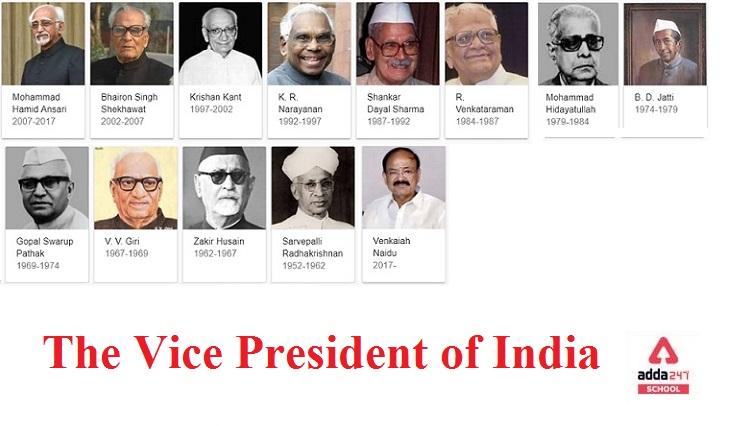Vice President of India
The Vice President of India – Eligibility, Election, Term, List is available here. After the President, the Vice President of India, officially the Vice President of the Republic of India, is India’s second-highest constitutional office. In the event of the president’s death, resignation, impeachment, or other circumstances, the Vice President takes over as President.
The Vice President of India (Muppavarapu Venkaiah Naidu)is also Rajya Sabha’s ex officio Chairperson. The vice president determines whether a bill is a financial bill or not when it is introduced in Rajya Sabha. If he believes a bill submitted in the Rajya Sabha is a money bill, he will report the matter to the Lok Sabha Speaker.
Read About Mother Teresa
Who is the vice president of india 2021-22?
Muppavarapu Venkaiah Naidu
All Vice Presidents of India List
This is a list of India’s vice presidents in order of service:
- Sarvepalli Radhakrishnan
- Zakir Husain
- V. Giri
- Gopal Swarup
- Basappa Danappa Jatti
- Justice M. Hidayatullah
- Ramaswamy Venkataraman
- Shankar Dayal Sharma
- Kocheril Raman Narayanan
- Krishan Kant
- Bhairon Singh Shekhawat
- Hamid Ansari
- Muppavarapu Venkaiah Naidu
The Vice President of India: Eligibility
To be eligible for election as Vice President, a person must meet the same criteria as the President:
- The person has to be an Indian citizen.
- Have attained the age of 35 years or more
- Holding a profit-making position is prohibited.
- While a person must be qualified for election as a member of the Lok Sabha (House of Peoples) to be President, a person must be qualified for election as a member of the Rajya Sabha to be Vice President (Council of States).
- This distinction is due to the fact that the Vice President will serve as the Rajya Sabha’s ex officio Chairman.
Read About Maharaja Ranjit Singh(Sher-e-punjab)
The Vice President of India: Election
The Vice President is chosen by a secret ballot by an electoral college made up of members of both houses of Parliament, in accordance with the proportional representation system and the single transferable vote. The vice-presidential election differs slightly from the presidential election in that members of state legislatures are not included in the electoral college, but nominated members of both houses are included in the electoral college for the vice-presidential election.
The election is overseen by India’s Election Commission. The election must take place within 60 days of the outgoing Vice President’s term of office expires. For the election, a Returning Officer is appointed. The Returning Officer publishes a public notice of the upcoming election, encouraging candidates to run. Any person who is eligible to be elected and wishes to run for office must be nominated by at least twenty members of parliament as proposers and at least twenty members of parliament as seconders. The Returning Officer examines the nomination papers and adds the names of all eligible candidates to the ballot.
The election is proportional representation via an open ballot with a single transferable vote. Voters rate the candidates in order of preference, allocating 1 to their first choice, 2 to their second choice, and so on. A candidate’s required number of votes to win an election is calculated by dividing the total number of validly cast votes by two, then adding one to the quotient while disregarding any remainder. If no candidate receives the required number of first-preference votes, the candidate who receives the fewest first-preference votes is eliminated, and his or her second-preference votes are transferred to another contender. The process is continued until the required number of votes are obtained by a candidate.
The Vice President of India: Term
The Vice President is elected for a five-year term. The Vice President is eligible for re-election an unlimited number of times. The office may, however, be terminated early due to death, resignation, or dismissal. Apart from re-election, the Constitution does not establish a process for succession to the office of Vice President in the event of an unusual vacancy. In such a case, the Vice President’s duties as Chairman of the Rajya Sabha can be performed by the Deputy Chairman of the Rajya Sabha.
If the President dies in office and the Vice President takes over as President, the Vice President can serve as President for up to 6 months before a new President is elected.
Also read Mahatma Gandhi Ji
The Vice President of India: Removal
The Vice President can be removed from office by a resolution voted by the Rajya Sabha with an effective majority and approved by the Lok Sabha with a simple majority. However, such a resolution cannot be introduced until at least 14 days’ notice has been given. Notably, there are no grounds for removal in the Constitution. No Vice President has ever been impeached, and the deputy chairman of the Rajya Sabha has never been challenged in court.
According to Article 71(1) of the constitution, the Supreme Court has the power to dismiss the Vice President if he or she commits election malpractices or fails to meet the eligibility conditions for a Rajya Sabha member while in office.
It is also the Supreme Court’s responsibility to investigate any suspicions raised about a Vice President’s conduct and, if the Vice President is found to be in contempt of the Constitution, to remove him.
Read About IG of Police
FAQs on Vice President of India list
Who was India’s first Vice-President?
The first Vice-President of India was Sarvepalli Radhakrishnan. From May 13th, 1952, until May 12th, 1962, he served as the first Vice-President of the United States.
Who is India’s current Vice-President?
Currently, India’s Vice-President is Venkaiah Naidu.
Is India’s Vice President a member of the Indian Parliament?
A person must be qualified for election as a member of the Lok Sabha to be President, and the Vice President must be qualified for election as a member of the Rajya Sabha to be Vice President.
Who is a Vice president?
After the President, the Vice President of India, officially the Vice President of the Republic of India, is India’s second-highest constitutional office.









 GSEB HSC Science Supply Result 2025 Down...
GSEB HSC Science Supply Result 2025 Down...
 DTE Maharashtra Polytechnic Merit List 2...
DTE Maharashtra Polytechnic Merit List 2...
 JEECUP Round 2 Seat Allotment Result 202...
JEECUP Round 2 Seat Allotment Result 202...









